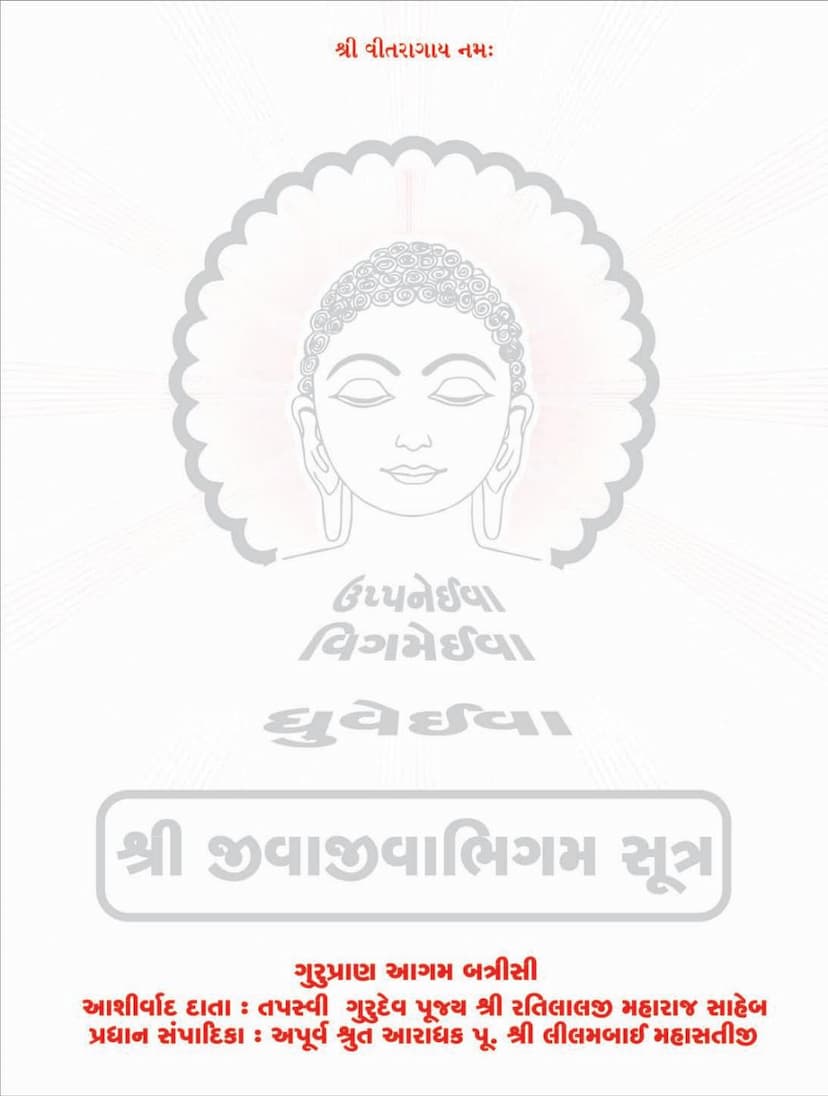Agam 14 Upang 03 Jivabhigam Sutra Sthanakvasi
Added to library: September 1, 2025

Summary
A comprehensive summary of the Jain text, "Agam 14 Upang 03 Jivabhigam Sutra Sthanakvasi," translated from Gujarati, is as follows:
Book Title: Agam 14 Upang 03 Jivabhigam Sutra Sthanakvasi Author(s): Punitabai Mahasati, Artibai Mahasati, Subodhikabai Mahasati Publisher: Guru Pran Prakashan Mumbai
This text is a Jain scripture, specifically an Upanga, detailing the "Jivabhigam Sutra." The provided pages offer a glimpse into its structure, content, and the devotional context surrounding its publication.
Key Themes and Content (Based on the provided pages):
- Devotional Context: The text is dedicated to the venerated Jain spiritual leaders of the Gondal Gachchh tradition, including Sri Dungarsinhji M.S.A., Sri Pranalalji M.S.A., and Sri Ratilalji M.S.A. The publication is marked by dedications and blessings from various revered Munis and Mahasatijis, indicating a strong emphasis on spiritual lineage and devotion.
- Structure and Scope: The book appears to be a detailed commentary or analysis of the Jivabhigam Sutra, which is part of the Jain Agamas (sacred scriptures). The extensive table of contents (Pages 15-21 and 18-21, 44-58, 71-86, 110-198, 210-246, 250-353, 370-457) reveals a meticulous classification and description of various beings (Jivas) and non-living entities (Ajivas). It delves into:
- Jiva (Living Beings): Detailed classifications of living beings based on their number of senses (ekendriya, beindriya, teindriya, chaurendriya, panchendriya), states of existence (like hellish beings, humans, animals, celestial beings), and their attributes. This includes discussions on their lifespans (sthiti), body composition (sharir), physical forms (samsthan), passions (kashay), consciousness (sanjna), dispositions (leshyā), and activities (yog, upayog).
- Ajiva (Non-living Entities): The text categorizes and explains the characteristics of Ajivas, including Pudgala (matter) with its various permutations (skandh, des, pradesh, paramanu), and the fundamental substances like Dharma (medium of motion), Adharma (medium of rest), Akasha (space), and Kala (time). The elaborate descriptions of these substances and their properties suggest a deep dive into Jain cosmology and metaphysics.
- Cosmology and Geography: The text appears to describe the Jain universe, including the various continents (dvipa), oceans (samudra), mountains (parvat), and the different layers of the universe (lok). The detailed mention of Jambudvipa, Lavana Samudra, and other geographical entities suggests a strong cosmological component.
- Concepts of Karma and Liberation: While not explicitly detailed in the provided summaries of the initial pages, the overall context of Jain scriptures implies a focus on karma, its bondage, and the path to liberation (moksha) through adherence to the principles of Jainism.
- Key Sūtras and Concepts:
- Jivabhigam Sutra: This is the core text being discussed. The name itself implies a detailed study of "living beings."
- Pratipatti (Perception/Viewpoint): The text is structured into "Pratipatti" sections (e.g., Pratipatti-1, Pratipatti-2, Pratipatti-3), suggesting different perspectives or levels of understanding concerning the subject matter. These sections seem to systematically analyze various aspects of existence.
- Drashtant (Examples/Analogies): The text uses analogies and examples (like the ladle analogy for Pudgala, or the description of divine beings' activities) to explain complex philosophical concepts.
- Numerical Classifications: The scripture is characterized by meticulous numerical classifications of beings, their attributes, and cosmological elements, reflecting the systematic approach of Jain philosophy. For example, the text mentions the 23 "dwar" (categories or aspects) related to beings, or the specific numbers of Yonis (birthplaces) and Kul-kotis (lineages).
- Publication and Editing: The publication details indicate a collaborative effort. The text highlights the contributions of Mahasatijis Punitabai, Artibai, and Subodhikabai as authors. The publisher is Guru Pran Prakashan, Mumbai. The text also mentions the primary editor (Pujya Shri Lilambai Mahasatiji), translators (Pujya Shri Punitabai M., Pujya Shri Punitabai M.), and other contributing Mahasatijis, emphasizing the effort involved in bringing this complex text to the public. The mention of multiple editions and print runs suggests its importance and popularity among the Jain community.
- Specific Details Mentioned:
- The text details the number of senses, the types of bodies (audarik, vaikriya, ahārak, taijas, karmaṇ), the classification of souls based on karma, the hierarchy of celestial beings (devatas), hellish beings (narakis), and various forms of life in the terrestrial realm.
- The descriptions of the hellish realms (naraka) are particularly graphic, detailing the hellish beings' suffering, their environments, and the types of punishments they endure.
- The text also elaborates on the characteristics of human beings, including their lifespan, sensory capabilities, and the different geographical regions (karmabhumi, akarmabhumi, antardvipa) where they reside, with varying lifespans and lifeways.
- The classification of celestial beings (devas) into Bhavanavasi, Vanavyantara, Jyotishi, and Vaimanika, along with their respective abodes and lifespans, is also present.
In essence, this text provides a systematic and detailed Jain perspective on the nature of living beings, their classifications, destinies, lifespans, origins, and the intricate workings of the Jain universe according to the Agamic tradition, particularly focusing on the Jivabhigam Sutra. The collaborative effort in its publication underscores its significance as a contribution to Jain knowledge and practice.